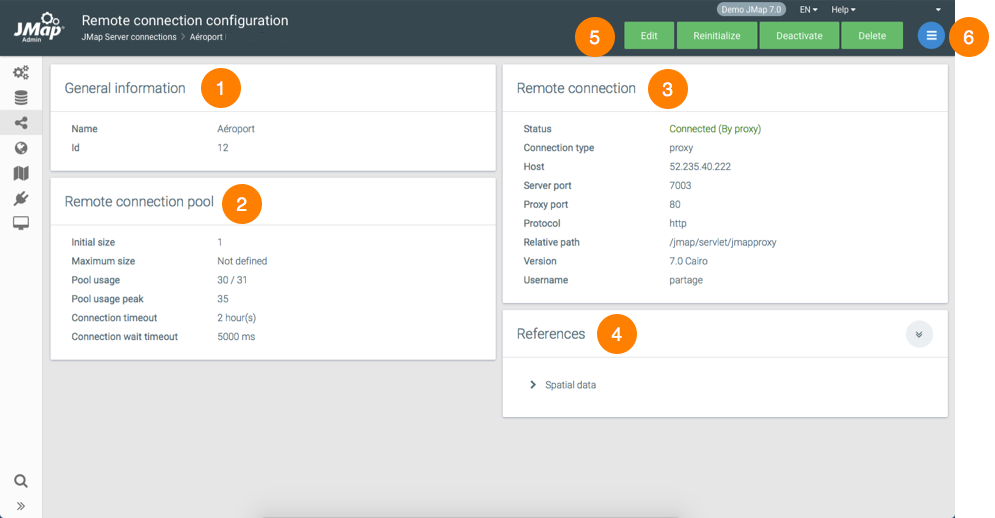It is possible to create connections from one JMap Server to another. These connections can then be used to share layers and spatial data sources between different JMap Servers while avoiding duplication of source data. They may also be used by some JMap Server extensions that require server to server communication. These connections are used, among other things, when creating JMap Server vector or JMap Server raster data sources and when using shared layers.
JMap Server manages connections towards other JMap Servers by placing them in pools.
Note that your JMap user license must allow server sessions in order for another JMap Server to connect to your JMap Server. For more information, refer to the JMap Server Status section.
The following diagram shows the connection between two JMap Servers (A and B) where the JMap application connected to server A accesses spatial data served by another JMap Server instance (server B).

Connection between 2 JMap Server instances
Creating Connections to JMap Server
To start creating a new connection, click on the Create button in the page listing the connections and follow the required steps.
Identification |
|
Name |
Enter a name for the new connection. The name chosen must be unique. |
Configuration |
|
Connection type |
Select the method used to connect to the remote server, either direct or proxy. This option may depend on the network configuration on the remote server side. Proxy connections use the HTTP protocol and therefore pass through firewalls easier. The parameters to enter will depend on the type of connection selected. |
Host |
Enter the name or IP address of the remote server to which you wish to connect. |
Server port |
(Direct connection) If you are creating a direct connection, enter the port used to establish the connection towards JMap Server. |
Protocol |
(Proxy connection) If you are creating a proxy connection, select the HTTP or HTTPS (secure) protocol used by the connection. |
Relative path |
(Proxy connection) If you are creating a proxy connection, enter the relative path to reach the JMap proxy. |
Proxy port |
If you are creating a proxy connection, enter the port used for the HTTP or HTTPS connection. |
Username |
Enter the user name for the connection towards the other JMap Server. This name must have a corresponding user account. |
Password |
Enter the password to connect to the other JMap Server. |
Advanced Parameters |
|
Number of connections |
Enter the initial size of the connections pool to determine the number of connections towards the other JMap Server that will remain open. |
Maximum connections |
Enter the maximum number of connections allowed for this pool. The number entered must be equal to or above the initial number of connections. If the pool's size must be increased, new connections will automatically be created until the maximum value is reached. The maximum value may be deactivated in order to increase the size of the pool, if needed. |
Connection timeout |
The connection inactivity timeout is used to close and reopen connections that are inactive for a long period. This mechanism ensures that the remote JMap server does not close inactive connections. Make sure that this value is lesser than the connection timeout of your JMap server. A default value of 2 hours is appropriate most of the time. |
Connection wait timeout |
The maximum wait time when opening a network connection to a remote JMap server. This parameter is used to prevent deadlocks in situations where the remote JMap server is not responding. |
When reinitializing a pool of connections to JMap Server, all open connections will be closed and new ones will be created. This action may be useful to force reconnection to a JMap Server.
Deleting a connection to JMap Server deletes this connection's entire configuration.
Connection statuses
Each connection has a status. This status indicates the condition of the connection towards JMap Server. The following table describes the possible statuses of a connection.
Status |
|
CONNECTED |
Connections to JMap Server were successfully created and are ready to be used. |
ERROR |
Connections to JMap Server are broken. The connection cannot be used until the error has been resolved and the connections have been reopened. Resetting the connection may resolve this issue. You can view a description of the error by clicking on the word Error displayed in red. |
Permissions for the remote connection
This section has two tabs: Permissions and Owners. The owners are the only ones who can manage the administrative permissions for the connection, manage the list of owners and delete it.
Permissions |
|
Administrate remote connection |
This permission allows you to modify the connection and manage user permissions on the connection. It doesn't allow you to remove the connection or to manage administrative permissions. |
Access remote connection |
Lets you see the detailed information of the connection and allows you to use the connection, without being able to modify it. |
Configuring JMap Server to JMap Server connections
When you click on the name of a connection, the Remote connection configuration interface displays.

1 |
General information about the connection. |
2 |
Remote connection pool configured when the connection was created. |
3 |
Information about the connection and the remote server, configured when the connection was created. |
4 |
References. This section lists the spatial data sources that use this connection. Clicking on their name will take you to their configuration page. |
5 |
Buttons to edit, reinitialize, deactivate or delete the connection. |
6 |
This menu allows you to access the Permissions section of the remote connection. |
Deactivating a remote connection
You can deactivate a remote connection without removing the connection configuration. The local server can no longer query the remote server. Deactivating a connection is useful when the remote server stops responding and causes delays in the local server.